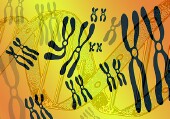Nonsense-mediated decay mutations linked to differential breast or ovarian cancer risk
TUESDAY, April 7, 2015 (HealthDay News) — The risk of breast and ovarian cancer varies with the type and location of BRCA1/2 mutations, according to a study published in the April 7 issue of the Journal of the American Medical Association.
Timothy R. Rebbeck, Ph.D., from the Perelman School of Medicine at the University of Pennsylvania in Philadelphia, and colleagues examined mutation-specific cancer risks for BRCA1/2 carriers. Data were assessed for an international sample of 19,581 BRCA1 mutation carriers and 11,900 BRCA2 mutation carriers from 55 centers in 33 countries. The hazard ratios for breast and ovarian cancer were estimated based on mutation type, function, and nucleotide position. The ratio of breast versus ovarian cancer hazard ratios was also assessed (RHR).
The researchers identified three breast cancer cluster regions in BRCA1 located at c.179 to c.505, c.4328 to c.4945, and c.5261 to c.5563 (RHR, 1.46, 1.34, and 1.38, respectively, indicating elevated breast cancer risk). An ovarian cancer cluster region was identified from c.1380 to c.4062 (RHR, 0.62, indicating ovarian cancer risk). Multiple breast cancer cluster regions were identified in BRCA2. There were also three ovarian cancer cluster regions. For both BRCA1 and BRCA2 mutation carriers, mutations conferring nonsense-mediated decay correlated with differential breast or ovarian cancer risks and an earlier age of breast cancer diagnosis.
“This study is the first step in defining differences in risk associated with location and type of BRCA1 and BRCA2 mutations. Pending additional mechanistic insights into the observed associations, knowledge of mutation-specific risks could provide important information for clinical risk assessment among BRCA1/2 mutation carriers, but further systematic studies will be required to determine the absolute cancer risks associated with different mutations,” the authors write. “It is yet to be determined what level of absolute risk change will influence decision making among carriers of BRCA1/2 mutations. Additional research will be required to better understand what level of risk difference will change decision making and standards of care, such as preventive surgery, for carriers of BRCA1 and BRCA2 mutations.”
Several authors disclosed financial ties to the pharmaceutical and biotechnology industries.
Copyright © 2015 HealthDay. All rights reserved.








